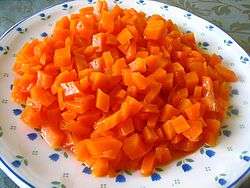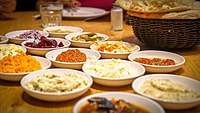Ashkenazi Jewish cuisine
Ashkenazi Jewish cuisine is an assortment of cooking traditions that developed among the Jews of Eastern, Central, Western, Northern, and Southern Europe, and their diaspora mainly concentrated in North America and other Western countries. Ashkenazi Jews have also been known as Western Jews (Ashkenazi is Hebrew for German). Jews of the Ashkenazi communities cook foods that were often unique to their community (and not popular among their local non-Jewish counterparts due to a history of limited interaction between the two groups), while often using local ingredients (such as beets, cabbage, and potato), and following the laws of kashrut. The cuisine is based largely on ingredients that were affordable for the historically poor Ashkenazi Jewish community of Europe, often composed of ingredients that were readily available in Europe and affordable and which were perceived to be less desirable and rarely used by their gentile neighbors, such as brisket, chicken liver, and artichokes, among other ingredients. As Ashkenazi Jews were typicall forbidden to grow crops in their home countries in Europe, their cuisine reflects that and there are less vegetable-focused dishes in Ashkenazi Jewish cuisine compared to their Sephardi and Mizrahi counterparts. Meat is ritually slaughtered in the shehita process, and is soaked and salted. Meat dishes are a prominent feature of sabbath, festival, and celebratory meals. Braised meats such as brisket feature heavily, as do root vegetables such as potatoes, carrots, and parsnips which are used in such dishes as latkes, matzo ball soup, and tzimmes. Cooked, stuffed and baked vegetables such as stuffed cabbage are central to the cuisine. Due to the lack of availability of olive oil and other fats traditionally used in Jewish cooking, fat from leftover chicken and goose skins (gribenes) called schmaltz is traditionally used in fleishig (meat) dishes, while butter is traditionally used in milchig (dairy) dishes.[1][2]
History
While Ashkenazi cuisine as it is known today is largely based within the context of American-Jewish and Ashkenazi-Israeli food, much of the culinary tradition of Ashkenazi Jews springs from Central and Eastern Europe. After having been expelled from Western Europe in the Middle Ages, Jews were forced to live in poverty and thus were limited in terms of ingredients. Dishes were made with fewer components; they were not heavily spiced and ingredients that were more flavorful had to be used sparingly. This is often why some dishes in Ashkenazic cuisine are known for being blander than dishes in Sephardic or Mizrahi cuisine.
Dishes
Baked goods
The hamentash, a triangular cookie or turnover filled with fruit preserves (lekvar) or honey and black poppy seed paste, is eaten on the Feast of Purim. It is said to be shaped like the hat of Haman the tyrant. The mohn kihel is a circular or rectangular wafer sprinkled with poppy seed. Pirushkes, or turnovers, are little cakes fried in honey or dipped in molasses after they are baked. Strudel is served for dessert. Kugels are prepared from rice, noodles or mashed potatoes.
Bread and cake
The dough of challah (called barkhes in Western Yiddish) is often shaped into forms having symbolical meanings; thus on Rosh Hashanah rings and coins are imitated, indicating "May the new year be as round and complete as these"; for Hosha'na Rabbah, bread is baked in the form of a key, meaning "May the door of heaven open to admit our prayers."
In Eastern Europe, the Jews baked black ("proster", or "ordinary") bread, white bread and challah. The most common form is the twist ("koilitch" or "kidke" from the Romanian word "încolăci" which means "to twist"). The koilitch is oval in form and about one and a half feet in length. On special occasions, such as weddings, the koilitch is increased to a length of about two and a half feet. The bagel, which originated in Jewish communities of Poland, is a popular Ashkenazi food and became widespread in the United States.[3][4]
Fats
The rendered fat of chickens, known as schmaltz, is sometimes kept in readiness for cooking use when needed. Gribenes or "scraps", also called griven, the cracklings left from the rendering process were one of the favorite foods of the former Jewish community in Eastern Europe. Schmaltz is eaten spread on bread.
Fish

With kosher meat not always available, fish became an important staple of the Jewish diet. In Eastern Europe it was sometimes especially reserved for Shabbat. As fish is not considered meat in the same way that beef or poultry are, it can also be eaten with dairy products (although some Sephardim do not mix fish and dairy). Even though fish is parve, when they are served at the same meal, Orthodox Jews will eat them during separate courses and wash (or replace) the dishes in between. Gefilte fish and lox are popular in Ashkenazi cuisine.
Gefilte fish (from German gefüllte "stuffed" fish) was traditionally made by skinning the fish steaks, usually German carp, de-boning the flesh, mincing it and sometimes mixing with finely chopped browned onions (3:1), eggs, salt or pepper and vegetable oil. The fish skin and head were then stuffed with the mixture and poached.[5] The religious reason for a boneless fish dish for the Sabbath is the prohibition of separating bones from food while eating [the prohibition of borer, separating]

A more common commercially packaged product found today is the "Polish" gefilte fish patties or balls, similar to quenelles, where sugar is added to the broth, resulting in a slightly sweet taste.[6] Strictly speaking they are the fish filling, rather than the complete filled fish.[7] This method of serving evolved from the tradition of removing the stuffing from the skin,[8] rather than portioning the entire fish into slices before serving.
While traditionally made with carp or whitefish and sometimes pike, gefilte fish may also be made from any large fish: cod, haddock, or hake in the United Kingdom.
The combination of smoked salmon, or whitefish with bagels and cream cheese is a traditional breakfast or brunch in American Jewish cuisine, made famous at New York City delicatessens.
Vorschmack or gehakte hering (chopped herring), a popular appetizer on Shabbat, is made by chopping skinned, boned herrings with hard-boiled eggs, sometimes onions, apples, sugar or pepper and a dash of vinegar.
Meat
Holishkes, stuffed cabbage, also known as the cabbage roll, is also a European Jewish dish that emerged from more impoverished times for Jews. Because having a live cow was more valuable than to eat meat in the Middle Ages, Jews used fillers such as breadcrumbs and vegetables to mix with ground beef. This gave the effect of more meat being stuffed into the cabbage leaves.
A spread of chopped liver, prepared with caramelized onions and often including gribenes, is a popular appetizer, side dish, or snack, especially among Jews on the eastern coast of North America. It is usually served with rye bread or crackers.
Gebratenes (roasted meat), chopped meat and Essig-Fleisch (vinegar meat) are favorite meat recipes. The Essig or, as it is sometimes called, Honig or Sauerbraten, is made by adding to meat which has been partially roasted with some sugar, bay-leaves, pepper, raisins, salt and a little vinegar. Knish is a snack food consisting of a meat or potato filling covered with dough that is either baked or grilled.
A popular dish among Ashkenazim, is pierogi (which are related to but distinct from kreplach), often filled with minced beef. Kishka is a popular Ashkenazi dish traditionally made of stuffing of flour or matza meal, schmaltz and spices.
Side dishes

Tzimmes consists generally of cooked vegetables or fruits, sometimes with meat added. The most popular vegetable is the carrot (mehren tzimes), which is sliced. Turnips were also used for tzimmes, particularly in Lithuania. In southern Russia, Galicia and Romania tzimmes was made of pears, apples, figs, prunes or plums (floymn tzimes).
Kreplach, are ravioli-like dumplings made from flour and eggs mixed into a dough, rolled into sheets, cut into squares and then filled with finely chopped, seasoned meat or cheese. They are most often served in soup, but may be fried. Kreplech are eaten on various holidays, among them Purim and Hosha'na Rabbah.
Soups

A number of soups are characteristically Ashkenazi, one of the most common of which is chicken soup traditionally served on Shabbat, holidays and special occasions. The soup may be served with noodles (lokshen in Yiddish). It is often served with shkedei marak (lit. "soup almonds", croutons popular in Israel), called "mandlen" or "mandlach" in Yiddish. Other popular ingredients are kreplach (dumplings) and matza balls (kneidlach) – a mixture of matza meal, eggs, water pepper or salt. Some reserve kneidlach for Passover and kreplach for other special occasions.
In the preparation of a number of soups, neither meat nor fat is used. Such soups formed the food of the poor classes. An expression among Jews of Eastern Europe, soup mit nisht (soup with nothing), owes its origin to soups of this kind. Soups such as borsht were considered a staple in Ukraine. Soups like krupnik were made of barley, potatoes and fat. This was the staple food of the poor students of the yeshivot; in richer families, meat was added to this soup.
At weddings, "golden" chicken soup was often served. The reason for its name is probably the yellow circles of molten chicken fat floating on its surface. Today, chicken soup is widely referred to (not just among Jews) in jest as "Jewish penicillin", and hailed as a cure for the common cold.[9]
There are a number of sour soups in the borscht category. One is kraut or cabbage borscht, made by cooking together cabbage, meat, bones, onions, raisins, sour salt (citric acid), sugar and sometimes tomatoes. Beet borsht is served hot or cold. In the cold version, a beaten egg yolk may be added before serving and each bowl topped with a dollop of sour cream. This last process is called farweissen (to make white).
Sweets and confections
Teiglach, traditionally served on Rosh Hashanah, the Jewish New Year, consists of little balls of dough (about the size of a marble) drenched in a honey syrup. Ingberlach are ginger candies shaped into small sticks or rectangles. Rugelach, babka, and kokosh are popular pastries as well.
In Europe, jellies and preserves made from fruit juice were used as pastry filling or served with tea. Among the poor, jelly was reserved for invalids, hence the practice of reciting the Yiddish saying Alevay zol men dos nit darfn (May we not have occasion to use it) before storing it away.
Flodni, a layered sweet pastry consisting of apples, walnuts, currants and poppy seeds, were a staple of Hungarian Jewish bakeries prior to World War II.
Because it was easy to prepare, made from inexpensive ingredients and contained no dairy products, compote became a staple dessert in Jewish households throughout Europe and was considered part of Jewish cuisine.[10]
See also
References
- Nathan, Joan. King Solomon’s Table.
- Marks, Rabbi Gil. The Encyclopedia of Jewish Food.
- Filippone, Peggy Trowbridge. “Bagel History: Bagels date back to the 1600s”, About.com website, retrieved March 27, 2013.
- Altschuler, Glenn C. (2008). ”Three Centuries of Bagels”, a book review of: 'The Bagel: The Surprising History of a Modest Bread', by Balinska, Maria, Yale University Press, 2008, Jewish Daily Press website, published on-line November 05, 2008 in the issue of November 14, 2008
- Попова, М. Ф., Секреты Одесской кухни, Друк, Одесса, 2004, p.163 (Russian); Popova M.F., Secrets of Odessa kitchen, Druk, Odessa, 2004, p.163
- Satz, Miriam, Heirloom cookbook: recipes handed down by Jewish mothers and modern recipes from daughters and friends, Kar-Ben, 2003, p.14
- Goodman, Hanna, Jewish cooking around the World: gourmet and holiday recipes, Varda Books Skokie, Illinois, 2002, p.147
- Garfunkel, Trudy, Kosher for everybody: the complete guide to understanding, shopping, cooking, and eating the kosher way, John Wiley & Sons, Inc., 2004, p.11
- "Jewish penicillin definition". Medterms.Com. Medicine Net.Com, a WebMD Company. Archived from the original on 2012-08-01. Retrieved 2012-07-12.
- Be Merry / A taste of Poland, Haaretz
.

